Every now and then you see something pop up on the auction sites that lodges itself in your brain so tenaciously and intensely that you just can’t get it out of there unless you do one of three things: try to buy it, drink yourself into a stupor, or write about it. I’ve tried the middle one and am working on the last one now, so I hope it helps. The car in question is this 1980 Fiat Strada with only 3,900 miles, offered with no reserve. It’s currently at $3,200.
This has to be the best-preserved Fiat Strada in America right now, no question. I don’t think there was a lot of competition for that title, but that doesn’t matter, this little Strada is definitely the winner. Now, it’s hardly the most appealing spec of Strada out there – it’s got a Volkswagen-derived three-speed auto, which, mated to that 1.5-liter, 69 horsepower engine, likely means that performance is, um, leisurely.
The engine looks very familiar to me, which makes sense, as it’s basically the same unit as was in the Fiat X1/9 and, more relevant to me, my old Yugo:
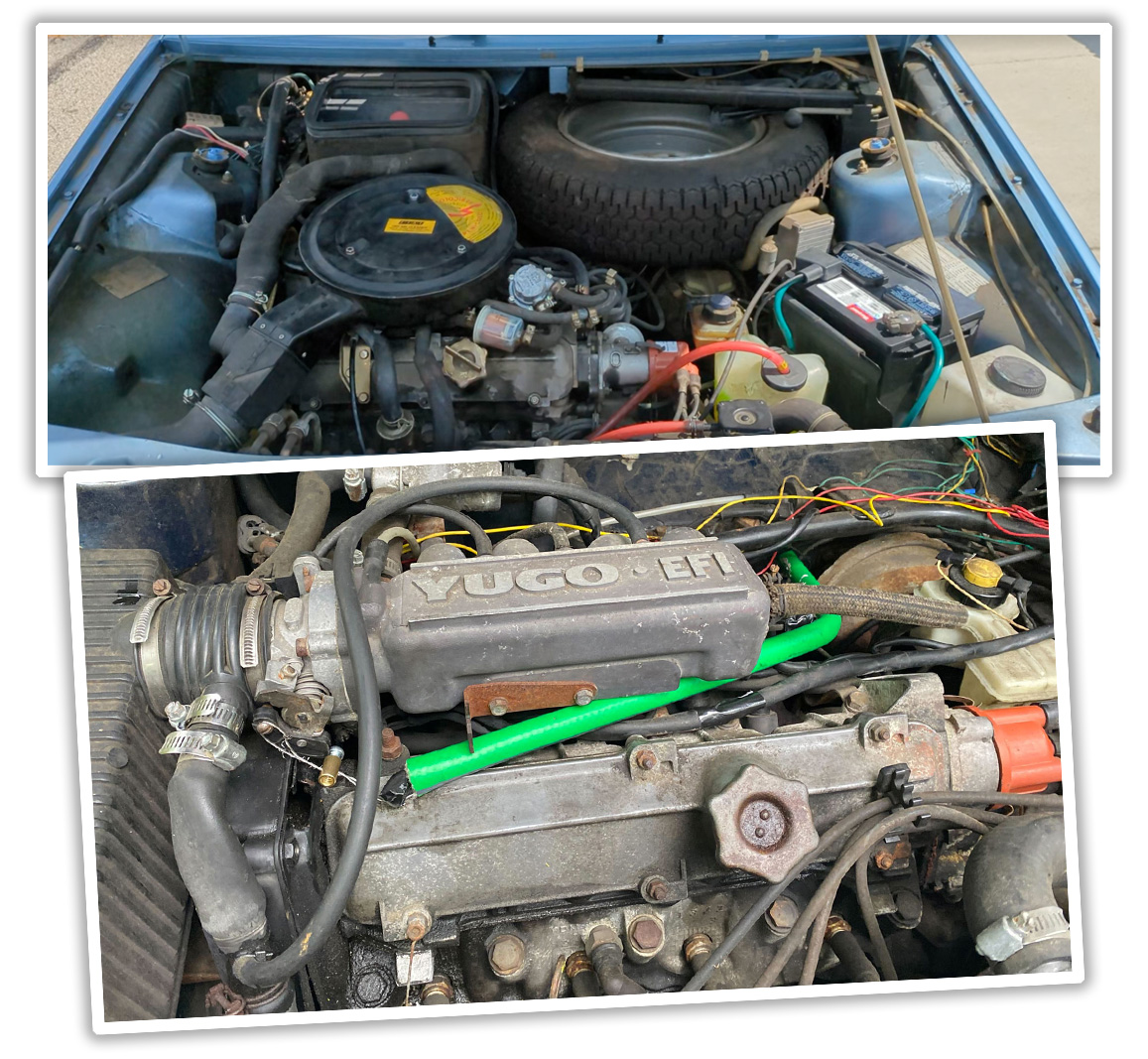
It’s not exactly the same – my Yugo had fuel injection, the Strada there has a carb, but the layout of the engine bay, right down to where the spare tire relaxes, is pretty much the exact same.
The Yugo also had a manual transmission, which helped wring every bit of power from those horses, which helped immensely. I’d wonder if you could swap one in to this Strada, but it’s so well-preserved, I’m not sure I’d want to touch it?
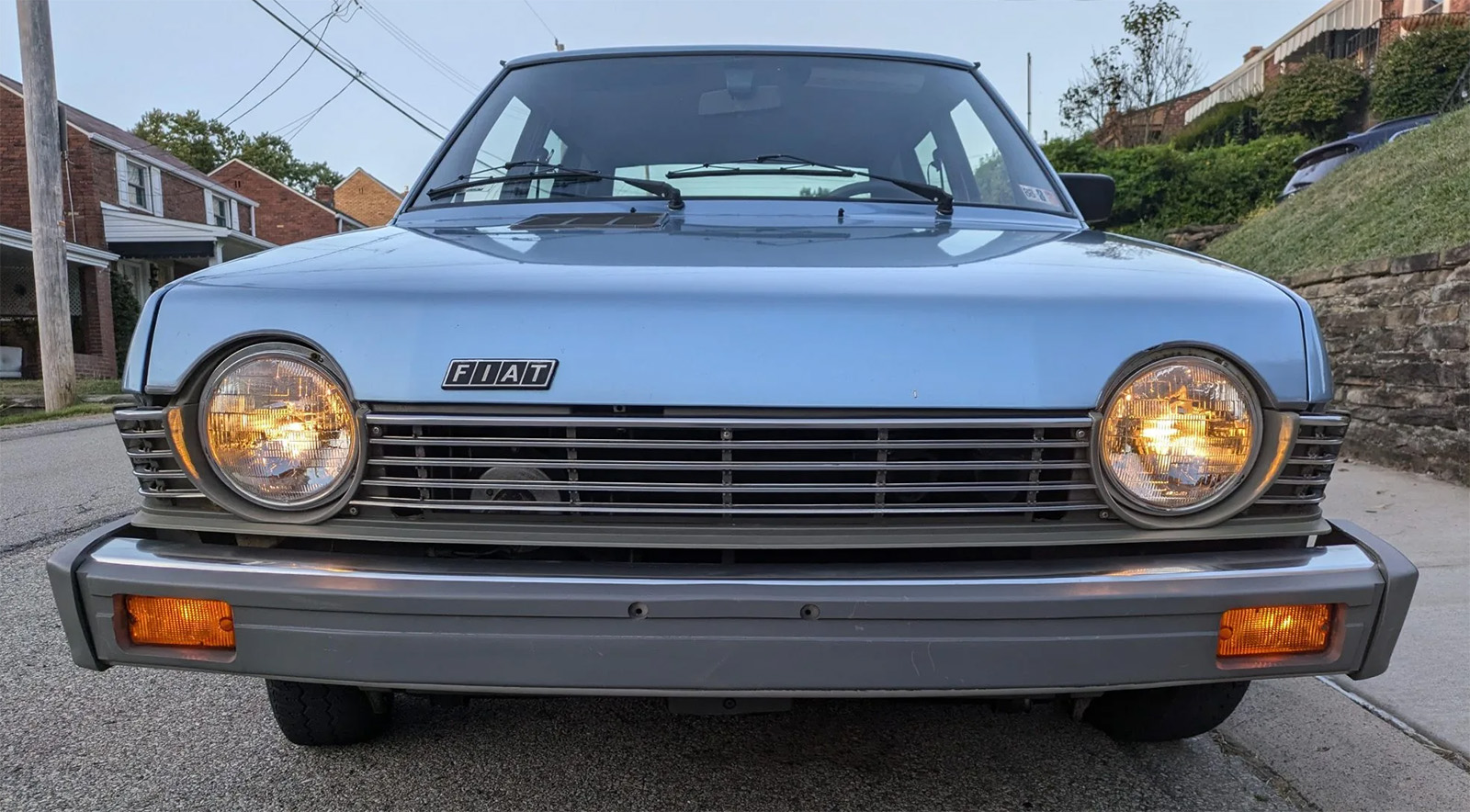
The car seems to have been bought by the proverbial Nice Old Lady who kept it immaculately maintained but didn’t actually drive it all that much. As a result, this thing has become a peculiar, preserved relic.
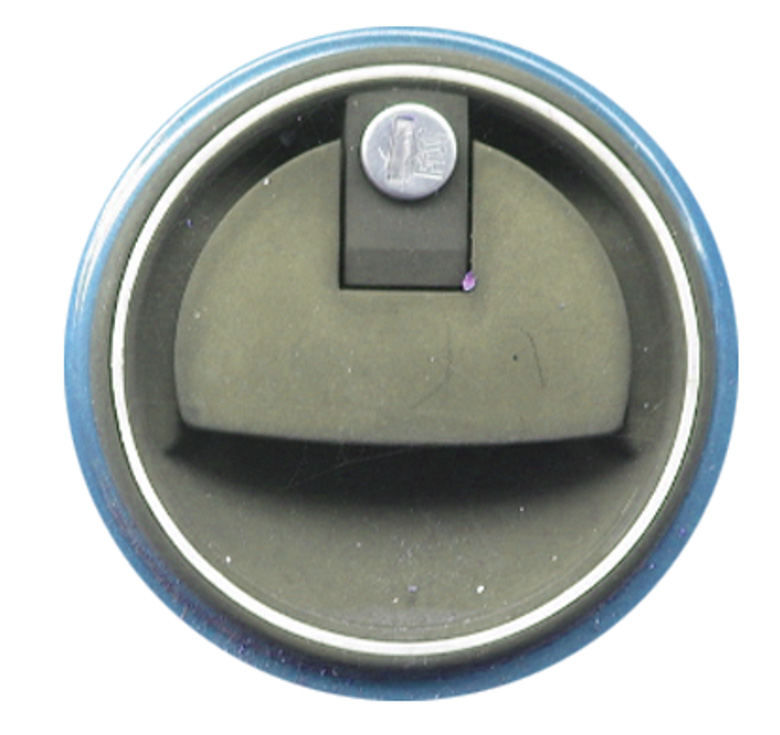
In the rest of the world, this car was known as the Ritmo, and was, I think, one of the best-designed cheap hatchbacks of the 1980s. I even wrote a whole article to just that effect. Of course, the Euro-market ones looked a good bit better; in America, the more functional but less attractive 5 mph bumpers take away from the look a bit, and we somehow couldn’t stop ourselves from fussying the whole look up in subtle yet design-destructive ways.
Here’s the Euro version:

…and here’s ours:

It’s subtle, but the changing of the grille to be that fake-chrome-trimmed one instead of the more bold asymmetrical one makes a big difference. The bumpers don’t help (visually, hit something, and they help a lot, of course) and when you put the less-cool wheels on it with out-of-place whitewalls, it just hits a little less hard:

That said, I still think the design is great – those round door handles – but let’s not fool ourselves into thinking this is a good car. I mean, it sort of was, but the quality control was early-’80s Fiat-grade, which is sort of like saying the tuna in your sushi is septic-tank-overflow-pond-grade.
To see what I mean, take a moment to watch this period review of the Strada:
That’s not great. It wouldn’t start, and look at this steering wheel alignment:

That’s on a new car. Damn.
So what does one make of something like this? It’s the best example of an interesting but kind of fragile car, and the mileage certainly is low, which I normally would avoid, but here I wouldn’t mind actually driving this one. I mean, look how perfect this interior is:
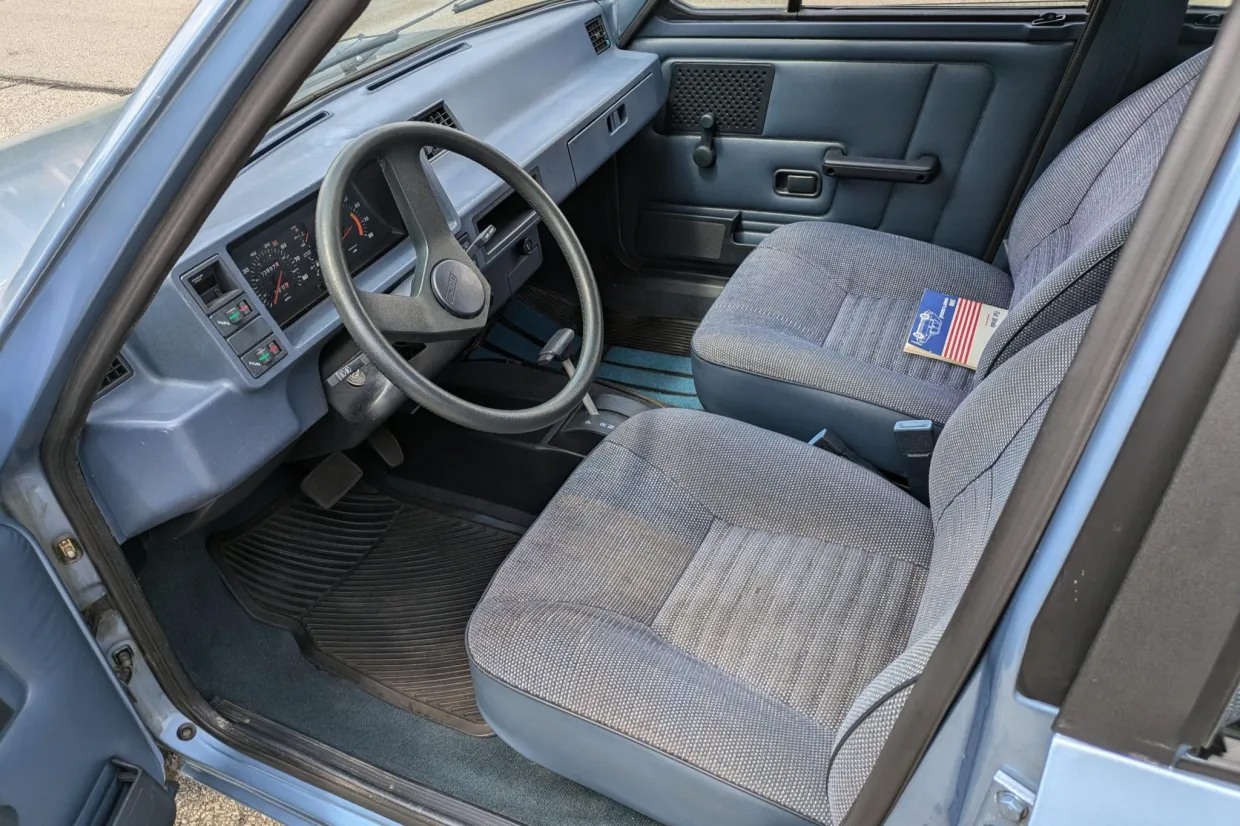
It’s got some wear, but the kind of wear you’d expect to see in, what, 1983? It’s a time capsule.
Also, it’s worth remembering that these were among the first cars to be almost entirely built by robots, 1980s robots even, like Johnny 5. Fiat made a big deal about this in their advertising:
So, what does one make of this car? At $3,200, it’s still a bargain, I think. I’m really not sure how to value this thing: it’s perhaps the best original example in America of a car that has pretty minimal appeal to most people. But it also has a lot of charm and appeal to a certain set of weirdos, like myself. Who’d going to end up with this thing? And how much will it go for? What is the perfectly-preserved automatic Fiat Strada market like in America right now?
I guess we’ll find out, in about a day. If any of you kooks buy it, please let me know!

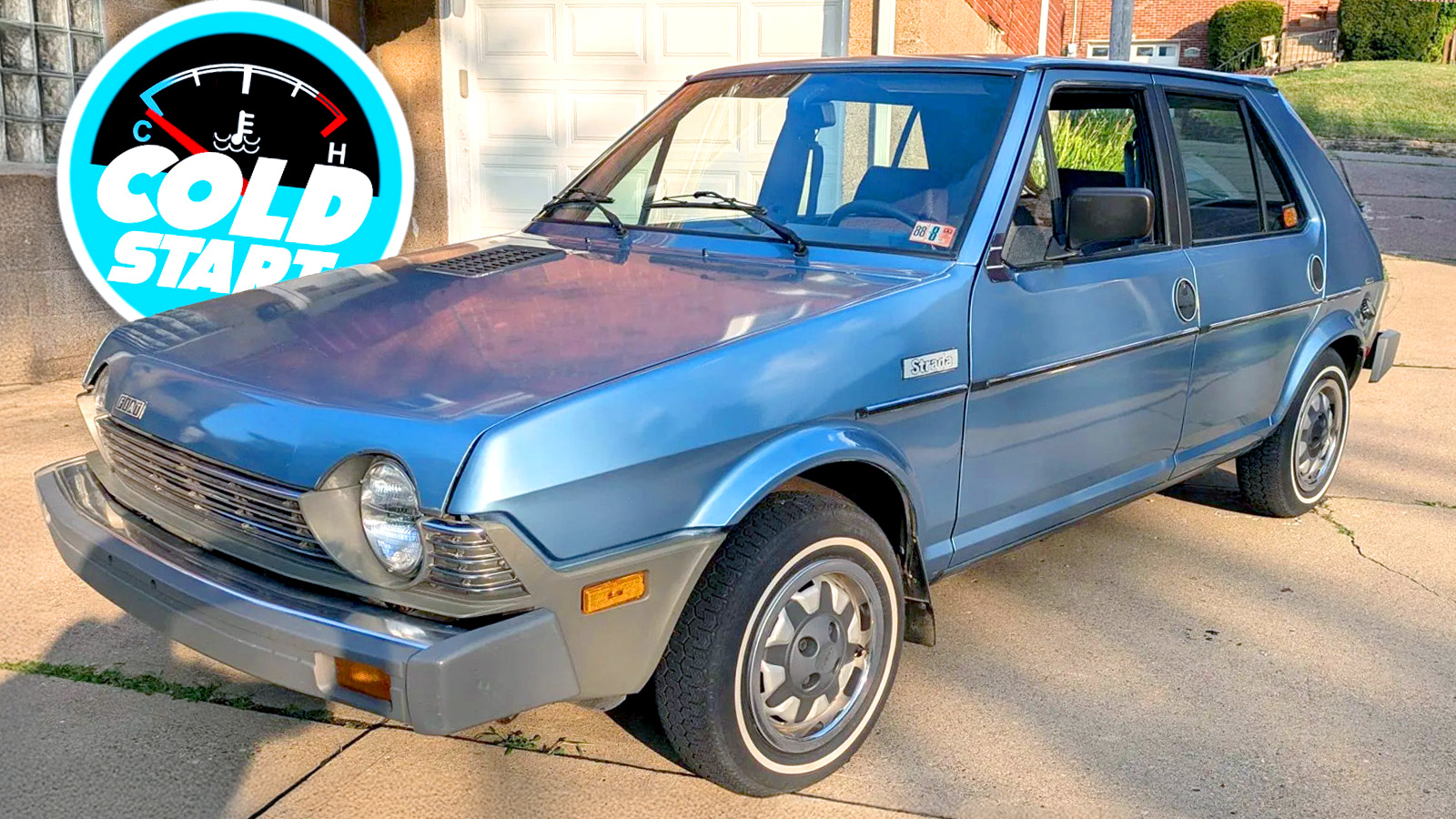







Hi there! I am the owner of this long-forgotten relic from Fiat’s past. As many have pointed out, I should probably have my head examined for buying this car. Admittedly, I have a soft spot for orphaned, unloved, and forgotten vehicles. My first experience with Fiat goes back to when I was 16 years old and took the driving test in my parent’s 131 sedan. I still remember the old man at the DMV taking one look at the car and said “What the hell is this?”. I also became the household chief mechanic as I tackled the issues of keeping various panels, knobs, and switches attached to the car. The heater valve leaked the day we drove it off the dealer’s lot.
Back to the Strada; Having sat for nearly 37 years, I knew there would be issues. The fuel tank had an impressive layer of varnish coating the bottom, which took several attempts to successfully clean, along with all the fuel lines. The seller had installed a new carburetor to make it run well enough for transport, but it also soon filled with varnish. A few months later, I now have it running and it’s everything I hoped it would be…and my bar was set pretty low.
Around town it’s fairly pleasant, if not painfully slow. I’m still building courage to merge onto an interstate. The automatic transmission certainly doesn’t help, but this car also has A/C. I’m certain, that if it worked, activating the compressor would cause the car to go backwards. On a positive note, the digital clock works great!
Winter is quickly approaching here in the midwest and will impede further progress. I hope to provide more information to those interested in early spring.
I was always intrigued by the door handles on these. I love the round shape. Jason, have you done a recent article on door handles? If not, an idea for a future article. your welcome in advance for a break from the vehicular ass articles..
This thing actually spent that much time in the shop that it only has 3K miles!
I’m such a sucker for US-spec european cars. They almost always look way worse than the original design, sure. Sometimes, USDM adaptations completely destroy the best aspects of a design (the Citroen SM and various Lamborghinis come to mind), and I can’t defend those. In some rare cases, I actually find the USDM version better looking – I find old Volvo wagons in US-spec even better looking than the original designs. In most cases, however, I can totally agree they look much worse than their EU-spec counterparts, but I still prefer the US-spec version. W123 wagons, for instance: I fully agree the original looks better, but I’d much rather have a USDM one.
This Strada could almost fall on this last category, if it weren’t for how they did away with the coolest aspect of the Ritmo – the unconventional, asymmetric grille (especilally considering the 5mph bumper looks no less of an afterthought in the overall design).
There’s a reason these have completely disappeared from the streets, unlike other cars of similar vintage. I’ll grant that the styling was great, but that was about it. Easier just hang up a nice photo of one.
Pretty sure Torch brings home every sickly stray dog he sees too.
5mph bumpers have ruined a lot of cars, but this has to be the worst. They could have easily just grown the black rubber snout a few more inches but instead they chose to just bolt on a completely incongruous bumper.
A college friend had an early 70’s 124 which she drove with verve. And I loved the blocky styling of the 124. The Strada that followed was just so ugly. Now, if you look up a Strada, it appears to be an Italian rendition of a Hyundai Santa Cruz.
Haven’t though about the Strada in years, but I thought it was a cool looking car. This one needs the EDM hubcaps (I thought they were ally wheels?).
I’m quite sure those are regular pressed steel plate type of wheels, just stamped and painted kinda unconventionally. I’ve actually even driven a Ritmo but it was years ago as I was 15.
“This has to be the best-preserved Fiat Strada”
I’m not sure what your are getting at. These didn’t even leave the factory in good condition. Even after dealer prep, someone I know who was fooled into buying one found parts on the floor she had to install herself.
I admit having a lot of experience with a ’79 two-door Strada in the mid ’80s. It had Bayless parts, aftermarket swaybars, Facet electronic fuel pump, driving lights under that ugly bumper, and other add-ons and hacks, including Michelin XZX tires like the pictured car here.
I always thought the XZX tread pattern looked cool. And there was a Pirelli Cinturato tread design I saw on an early or mid 60s Citroen that was interesting.
Empirical data eclipses “what looks cool,” in the real world, but there is something to be said, aesthetically, for a cool tread design.
The XZX was an exceptional mainstream tire of its day, with very good rain and snow traction. Liked it a lot back then. It’s even available today in limited classic fitments. The Continental TrueContact Tour is a modern interpretation I bought for two SUVs in recent years.
Today, my favorite cool-tread tire is the Continental DWS06+. I have a set on one of my cars today.
Yeah. I bought some Continental tire (Control Contact Tour M A/S) that apparently is custom made for Discount Tire. So much better than the Goodyear Eagle LS tires that the car came with from the factory. Those things were pretty scary when it rained hard and there was standing water on the roadway.
The DWS06+ do look cool.
I’ve got almost 30K miles on these Contis and they look like they’ll go a lot further before needing replacement.
In the under hood engine comparison shot, I can see the Fiat’s engine air filter getting air via a duct leading to the front of the car and not the adjacent hood grille duct. Is that a cabin air intake, then?
Yes, that hood scoop and air box are for the HVAC system, which was dreadful.